SIMA 2017, the Paris International Agribusiness Show that will be held Feb. 26 – Mar. 2, has announced five farm equipment manufacturers are being awarded silver medals in the group’s 2017 Innovation Awards for agricultural equipment program.
The award winners were selected by a panel of 25 experts from France, and headed up by Jean-Marc Bournigal, chairman of the French National Research Institute of Science and Technology for Environment and Agriculture.
Silver Medal: Case IH Agriculture’s Autonomous Cabless Tractor
At key moments in the year, such as during preparation and sowing, working constraints mean that extra workers are required for these peak periods, which must be successful for crops to be profitable. 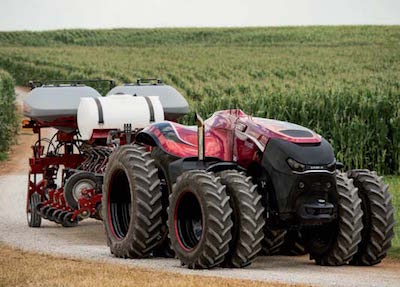
The autonomous vehicle concept is a cabless wheeled tractor that can operate autonomously in the field, with a wide range of Isobus tools. It combines the latest breakthroughs in orientation, telemetry, data sharing and agronomic management to provide managers of agricultural enterprises with additional working capacity. In fact, the autonomy of the tractor and the associated Isobus toolkit makes it possible to work autonomously, day or night.
On this tractor, based on a Case IH Magnum model, removing the cab offsets the additional technology to make it work autonomously. With interactive interface for PC or tablet, the operator can remotely supervise pre-programmed operations. The on-vehicle system tracks the most efficient trajectories depending on the soil and the attachment, any obstacles, and any other machinery being used in the same field. Using radar, lidar and on-vehicle cameras, the vehicle can detect obstacles and stop by itself until the operator, alerted by the audio and visual signals, assigns it another path.
The vehicle will also stop immediately if the GPS signal or position data are lost or the manual stop button is pressed. Changes can be made to the machine’s tasks in real-time, with remote interface or automatic weather alerts.
Silver Medal: JCB Agri’s Variable Transmission System Combines Hydrostatic & Powershift Technologies
Currently available transmissions on telescopic farm forklifts (all brands) are mechanical, Powershift, hydrostatic or continual variation 100% hydrostatic. Yet in the use made of telescopic forklifts, they have two distinct uses. About 60% of the time, they are used for low-speed applications like pallet handling, livestock feed and forage or loading grains or manure. For this use, the hydrostatic transmission is the most suitable because it’s flexible and precise, and transfers lots of torque at low speed. It also makes for gentle reverses in direction, active hydrostatic braking and independent engine speed and RPM.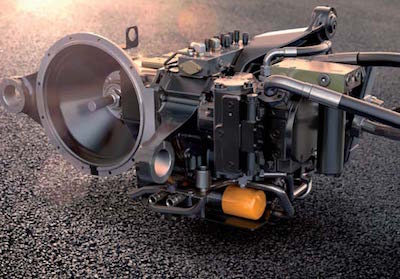
On the contrary, these machines spend 40% of their time on the road, relocating or towing a trailer. For this type of application, mechanical transmissions that feature full-throttle shifting, known as Powershift, are ideal, because they provide optimal energy efficiency along with great traction strength when shifting, during which time there is no interruption in the power being transferred to the wheels.
The JCB Dualtech VT transmission combines the best of these two worlds, with a hydrostatic module operating from 0-19 km/hr. and a direct three-ratio Powershift module from 19-40 km/hr. Shifting gears is fully automated from 0-40 km/hr. for ease of use, comfort and optimal productivity. In addition, with the hydrostatic module, the engine power and forward drive speed can be controlled independently in FLEXI mode. It also has two operating modes, ECO and POWER, to adapt the transmission’s operation to the application.
Silver Medal: John Deere Smart AutoLube Intelligent Tractor and Tool Greasing System
John Deere’s Smart AutoLube system lubricates with a single station for (at least) four independent sections and greasing points of the tractor and its attachments. From the cab, you can select the operating mode (manual, automatic, custom), adjust the settings and monitor the work. In automatic or custom mode, the grease is distributed according to the equipment’s use. Instructions are sent to the system from pre-entered data and decision rules and variables that are continuously measured. This variable command control is the core of innovation.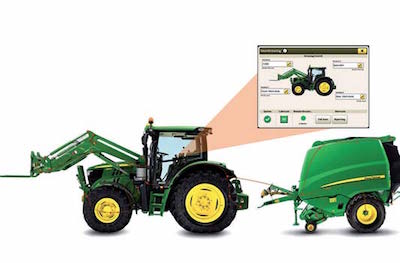
The information, if any, coming from the BusCan on the tractor and/or “Isobus-ready” toolkit (automatically recognized) is inside information, otherwise it is collected with additional sensors (e.g. motion sensors on front loader).
In manual mode, the user can perform lubrication in special circumstances (e.g. after washing the equipment before storage). Technical features, user comfort and access to the different modes’ settings and configurations make for optimal use of the equipment (tractors and toolkit) with reduced maintenance costs and less risk of losing resale value on them.
For customers, there are many pluses: optimized lubrication, in-cabin control and reduced risk of accidents when accessing grease nipples, less downtime for lubrication and zero omission of grease nipples, more easily scheduled preventive maintenance, tracking and control of lubricant consumed, by section, with reduced excess, reduced frequency and costs of replacing pivot points due to a nearly 30% reduced risk of abrasion.
Silver Medal: New Holland’s NHDrive Highly Versatile Autonomous Tractor
The NHDrive autonomous tractor combines the technologies that it can use to work without a driver in the field, while offering the versatility of a traditional tractor during transport or activities requiring the driver’s undivided attention. There are autonomous tractors on the market, but only driving was integrated.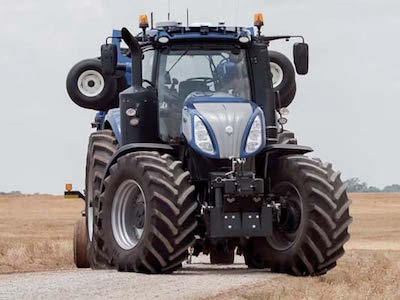
The NHDrive goes even further, allowing a degree of autonomy never before achieved in agriculture. It can both detect and analyze the direct environment in real-time, while taking into consideration the condition and performance level of the tractor’s essential components, as well as the toolkit’s to fully automate the tasks defined by the farmer.
It becomes possible for users to manage work remotely from the farm office or from another tractor working in the same parcel of land. The robust protocols and software solutions guarantee the user maximum availability of his production toolkit and and peace of mind.
The NHDrive concept is based on specific developments that involve the following innovative technologies: a planner to create the optimal trajectories within a parcel; sensors to analyze the environment (Lidar, radar and cameras); information coming from the equipment to adjust settings as needed; intensive integration of subsystems between tractor and attachment; multi-faceted communications technology guaranteeing ongoing exchange of critical data between the remote user and the machine, regardless of geographic diversity; one application, available on PC or tablet, that gives remote users total access to the machine to respond to alerts, monitor the work in progress and, if needed, make changes to the mission.
Silver Medal: Rousseau’s E-Kastor, An Electric Rotor-Driven Side-Mounted Edge Cutter
Based on the Kastor edge-cutter model, the E-Kastor combines an electric power transfer system for the shredder head, while keeping hydraulic control of the moving jacks. Installation of an electric power transfer system onto a side-mounted edge-cutter is the result of an environmentally friendly design, which gives users equipment that uses less energy, with better yield from the linkage, and meets the demand for energy transition.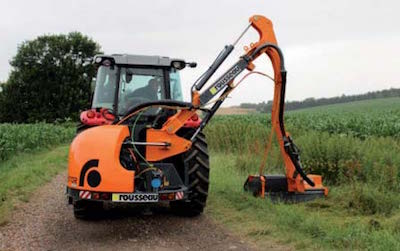
This electric system transmits the mechanical power of the tractor’s power takeoff to the shredder head by means of a generator paired with an electronic device. The rotor turns thanks to electricity, while the cooling of the electric power components (generator, control box and engine rotor) is performed by a 50/50 mixture of water and glycol.
This design, which combines an electric power system with the tractor’s hydraulics, bypasses the oil reservoir that is indispensable in the case of a hydraulic motor rotor. The machine is streamlined and therefore simpler in design.
The system uses two identical synchronous machines. One is used as an electric generator, towed by the tractor’s power takeoff, and the other is used as a motor to drive the shredder head rotor. Each of these two synchronous machines is paired with a power inverter. The first one provides steady voltage to the generator, by adapting the intensity to power requirements, while the other one controls the rotor’s motor speed within an operating range of 0-4000 turns/min. A resolver cable provides the controls as well as the return of information such as speed, operating power and temperature.





